Profile: A human touch for animals
Temple Grandin champions raising livestock without fear or harm
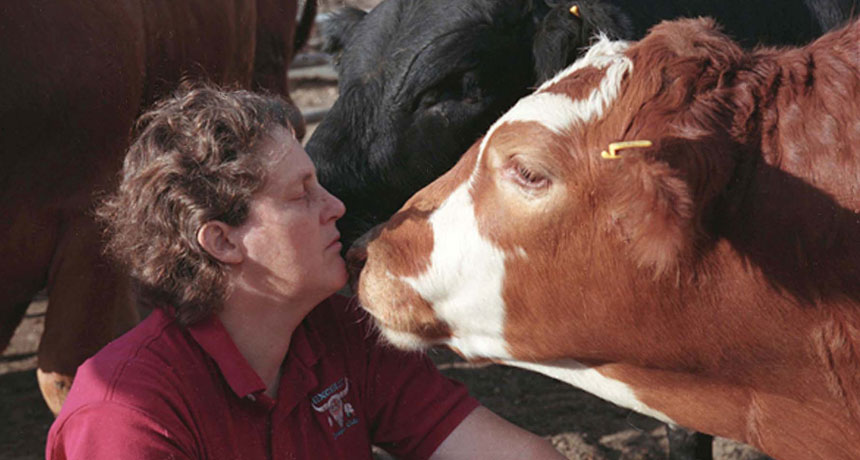
Temple Grandin understands how to act around animals without frightening them. Sometimes after cattle have had a chance to get used to her, she will kiss them on the nose.
Rosalie Winard
Temple Grandin, 68, is one of the world’s top experts on nurturing farm animals. She trains farmers and ranchers to raise livestock without causing them pain or fear. Those methods and insights make their care — called animal husbandry — faster and easier because the animals do not become anxious.
Grandin also has designed slaughterhouses, facilities where animals are killed for food. Animals move through these facilities without stress. Death comes instantly and painlessly. About 30 million cattle are killed for meat every year in the United States. Today more than half of those cattle are processed in systems that Grandin designed.
Sometimes people ask how Grandin can work with an industry that kills animals. She believes that as long as people eat meat and use animal products, her work is needed. “We owe animals a life worth living,” she explains.
Grandin teaches animal science at Colorado State University in Fort Collins. Livestock farmers from around the world seek out her expertise. That’s not the only thing that keeps Grandin busy — or the only reason she is so well known.
Grandin is also one of the world’s most famous people with autism. She speaks to the public frequently about this condition, which occurs when some parts of a child’s brain don’t develop typically. People with autism often have trouble understanding and communicating with others. Grandin has turned her autism into an advantage. She thinks in pictures, not words. She believes that her visual thinking helps her see the world from the perspective of the animals she helps. It also helps Grandin imagine and design systems for handling animals without scaring them.
It’s easy to recognize Grandin. She always wears western shirts. She also says just what she thinks. Actress Claire Danes played Grandin in an HBO movie about her life. Grandin receives awards from the livestock industry and from groups that work to protect animal welfare. These two sides often clash — but when Grandin talks, they listen.
A different kind of mind
Grandin grew up in Dedham, Mass. It’s a small town outside Boston. Her autism made her different from other children. Loud sounds upset her. When Grandin grew frustrated, she threw tantrums. But she also had friends and activities that she loved — especially making things.
“I used simple materials like crepe paper, cardboard and old sheets,” she recalls. “I experimented with parachutes and made kites that flew behind my bike.” Her favorite class in school was art. She also liked carpentry and sewing.
Today, Grandin gives talks about understanding people with what she calls “specialized minds.” These include people with autism, dyslexia (a learning disability that affects reading) and attention-deficit hyperactivity disorder (ADHD). “Often they are like me: very bad at algebra but good at graphics, arts and industrial design. And when people with different kinds of minds work together, you get better results,” she says.
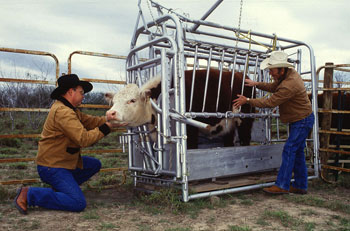
Growing up, things got harder for Grandin in seventh grade. She went to a new school. The other girls teased her. By ninth grade, she was expelled for throwing a book at another girl. She switched to a New Hampshire boarding school for children who were smart but struggled in regular schools. One of Grandin’s favorite activities there was riding horses. When a horse grew frightened or upset, she often found ways to calm it.
One summer, Grandin visited her aunt’s ranch in Arizona. There, she saw a cattle chute (sometimes also called a squeeze chute). The narrow pen had sides that could press together. The design holds cattle still while they receive shots or other treatment. After seeing how the pen calmed down cattle, Grandin asked her aunt to close her inside it. She felt safe and calm inside, as though someone was protecting her.
Back at school, Grandin built her own squeeze machine. Her science teacher encouraged her to study whether it could calm other students too. She found many students liked it. Observing their responses and collecting data made Grandin want to become a scientist.
Grandin kept analyzing her squeeze machine in college while earning a degree in psychology. She also studied animal behavior and genetics. Throughout, she remained interested in how animals thought. “I saw a movie in high school that used a distorted room to create optical illusions,” she recalls. “I was fascinated. It made me think about how animals perceived things, because animals see in pictures too.”
The girl at the feedlot
Grandin earned a master’s degree and then a doctorate in animal science. She studied how animals behaved in different types of structures, such as cattle chutes. At the time, few women worked in the livestock industry. Once, when Grandin went to study cattle that were being fattened up on grain for market, some men told her to leave. Another time, she found her car covered with blood and gore from slaughtered cattle.
“Cowboy foremen felt threatened by a girl nerd on the feedlot,” she remembers. “But now it’s different. Today veterinary medicine is 80 percent female.”
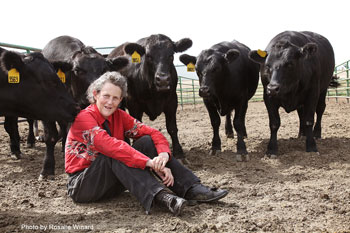
Grandin began to observe how animals often were afraid of small details that most people ignored. She also noticed how simple changes often solved the problem. “I would do something like pick up a hose from the floor, or light up a chute that was dark. Then cattle would walk right through a place where they had refused to go,” she says. “It amazed me that I could do something so simple and take away their fear.”
After graduate school, Grandin kept working with livestock farmers. She redesigned dip vats — big pools for bathing farm animals in anti-insect solutions — so that cattle would walk into them without panicking. And she developed new designs for slaughterhouses. Rather than force cattle on a straight path, her designs led the animals along curving runways. Cattle follow these curved pathways, calmly and orderly, until they could be killed humanely.
A new problem to solve
In Grandin’s view, the handling of animals at stockyards and slaughterhouses is much more humane now than when she started her work. But today she is worried about a new problem. She calls it “biological system overload.” In her view, many farmers and ranchers are too focused on breeding animals that will produce lots of meat, milk or eggs. They selectively breed animals with these traits. But they don’t think about other traits, such as strength or resistance to disease. As a result, Grandin sees many animals that lead shorter and less healthy lives.
“We’ve bred animals that produce really well, but they have a lot of weaknesses,” she explains. “People think that if they change an animal’s genetics, they can breed a cow that makes lots of milk, has lots of calves and will have a body that can also fight off disease. But it takes energy to do all of those things. You can’t feed a cow enough to support all of those systems.”
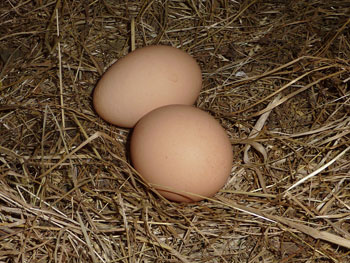
Another example is a hen bred to lay lots of eggs. Eggshells are made of calcium. This chemical element also makes for strong bones. On large farms, Grandin has seen laying hens — those kept as egg producers — that have osteoporosis (OS-tee-oh-puh-ROH-sis). This disease causes the bones to become weak and brittle. Eventually, the bones can break. “These hens are pushed so hard to produce eggs that all the hard stuff is being removed from their bodies,” Grandin says.
Like many Americans, Grandin eats meat. She does not want to end livestock farming. Still, she believes farmers should breed animals that will be healthy and strong. “I want to know how we can breed a smaller cow that gives a little less milk but lives longer,” she says.
When animals produce less milk or meat, farmers might worry about making less money. But Grandin points out that breeding healthier animals actually can benefit farmers. “It takes energy for animals to maintain their immune systems,” Grandin explains. “If animals don’t have strong immune systems, they get sick and die more easily.” And when livestock die, farmers definitely lose money.
Lessons from the wild

Grandin thinks scientists can learn about improving livestock health by studying wild species. Indeed, it may offer help in slowing avian influenza. This bird flu swept through chicken and turkey farms in 15 states across the U.S. Midwest during the spring and summer of 2015. Even when just a few birds get sick, farmers have to slaughter the whole flock. That serves to limit the spread of the virus. The 2015 outbreak proved costly. Farmers ended up killing almost 50 million chickens and turkeys.
“Many wild birds get just a little bit sick from avian influenza, but domestic birds catch it and die. Why is that? Can we breed some of that strength into domestic animals?” Grandin wonders. “Let’s take DNA from farm-raised turkeys that die of bird flu and compare it to mallards, wild ducks and snow geese. I want to find out what the wild birds have and the farmed ones don’t.”
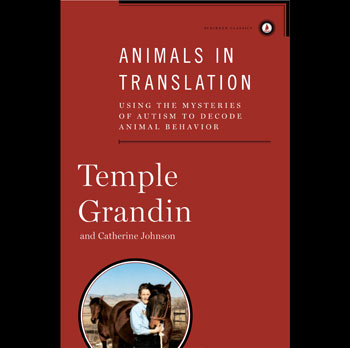
There may be many more thing people can learn from animals, she notes. For instance, how do birds learn to follow migration routes that stretch thousands of kilometers (miles)? Or how do squirrels remember where they buried nuts during autumn? Or why can some dogs be trained to help people with epilepsy by warning when a seizure is coming?
“I think we’re letting a huge amount of talent go to waste, both in people who aren’t ‘normal’ and in animals who are. That’s probably because we don’t understand what animals could do if we gave them a chance,” she writes in her book Animals in Translation. This is just one of the more than 30 books Grandin has published.
Through her work, Grandin has tried to demonstrate that animals are smarter than we think — and that treating animals well makes us better people.







